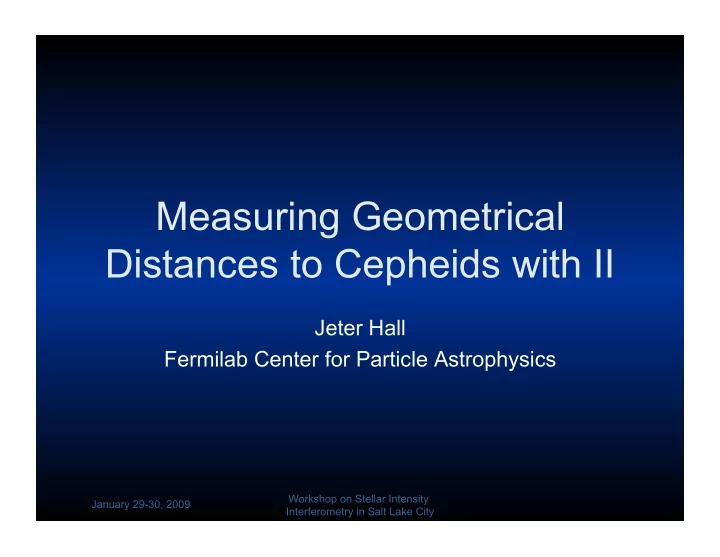

Measuring Geometrical Distances to Cepheids with II Jeter Hall Fermilab Center for Particle Astrophysics Workshop on Stellar Intensity January 29-30, 2009 Interferometry in Salt Lake City
Cosmic Distance Distance Ladder Redshift • Variable stars used to measure the Hubble diagram – Supernovae bright (M<7) enough are quite rare – A few cepheids are bright enough for II Workshop on Stellar Intensity January 29-30, 2009 Interferometry in Salt Lake City
Bright Northern Cepheids STAR RA DEC V_MAGMEAN B_MAGMEAN <SIZE> ∆ SIZE � [mas] [mas] � (Dec>20): � Alp UMi 2h32m 89 o 1.9 2.5 3.1 (CHARA) 0.01 � Del Cep 22h29m 58 o 3.9 4.6 1.5 (CHARA) 0.2 (CHARA) � Zeta Gem 7h04m 21 o 3.9 4.7 1.7 (PTI/CHARA) 0.2 (PTI/CHARA) � RT Aur 6h28m 30 o 5.4 6.1 0.7 0.07 � DT Cyg 21h31m 31 o 5.7 6.3 0.6 0.02 � V1334Cyg 21h19m 38 o 5.8 6.3 0.5 0.01 � T Vul 20h51m 28 o 5.8 6.4 0.6 0.07 � SU Cas 2h51m 69 o 5.9 6.6 0.7 0.02 � V473 Lyr 19h15m 28 o 6.2 6.8 complicated � (-20<Dec<20): � Eta Aql 19h52m 1 o 3.9 4.7 1.8 (PTI/VLTI) 0.2 (PTI/VLTI) � FF Aql 18h58m 17 o 5.3 6.1 1.0 0.04 � S Sge 19h56m 16 o 5.6 6.4 0.8 0.1 Workshop on Stellar Intensity January 29-30, 2009 Interferometry in Salt Lake City
Geometrical Baade-Wesselink Method • Measure linear expansion spectroscopically – Optical • Measure angular expansion interferometrically – FIR - NIR • Calculate distance – Improve the current 10% calibration on the Hubble diagram zero point Workshop on Stellar Intensity January 29-30, 2009 Interferometry in Salt Lake City
Linear Expansion Velocities • Spectral shift measured with cross correlation of the optical spectrum • State of the art ∆ V r ~ 1 m/s – Driven by searches for extrasolar planets • Typical Cepheid <V r > ~ 10 km/s • Can be done simultaneously with a spectroscopic II Workshop on Stellar Intensity January 29-30, 2009 Interferometry in Salt Lake City
Spectroscopic II Camera Polarizing BS Collector/Collimator Workshop on Stellar Intensity January 29-30, 2009 Interferometry in Salt Lake City
Angular Diameters • Translation from UD to LD requires detailed modeling • Additionally, evidence for CSE in interferometric measurements of Polaris (~1.5%) • CSE complicates picture for Cepheids “however, it seems likely that the CSE effects… are less important at shorter wavelengths” Workshop on Stellar Intensity January 29-30, 2009 Interferometry in Salt Lake City
Conclusions • Cepheids seem to be good scientific targets for intensity interferometry • Next step is to investigate models and quantify the increase in information at optical wavelengths • Current modeling in optical is based on ambitious NASA projects like the Stellar Interferometer Workshop on Stellar Intensity January 29-30, 2009 Interferometry in Salt Lake City
Selected References • First detection of angular diameter changes Lane et al. Nature 407 , 485-487 (2000) Lane et al. ApJ 573 , 330-337 (2002) • Catalogue of Cepheids appropriate for interferometric measurements Moskalik & Gorynya Acta Astronomica 55 , 247-260 (2006) • Survey of 7 Cepheids with VLTI Kervella et al. A&A 416 , 941-953 (2004) • Detection of CSE around Polaris Mèrand et al. A&A 435 , 155-162 (2006) Workshop on Stellar Intensity January 29-30, 2009 Interferometry in Salt Lake City
Recommend
More recommend